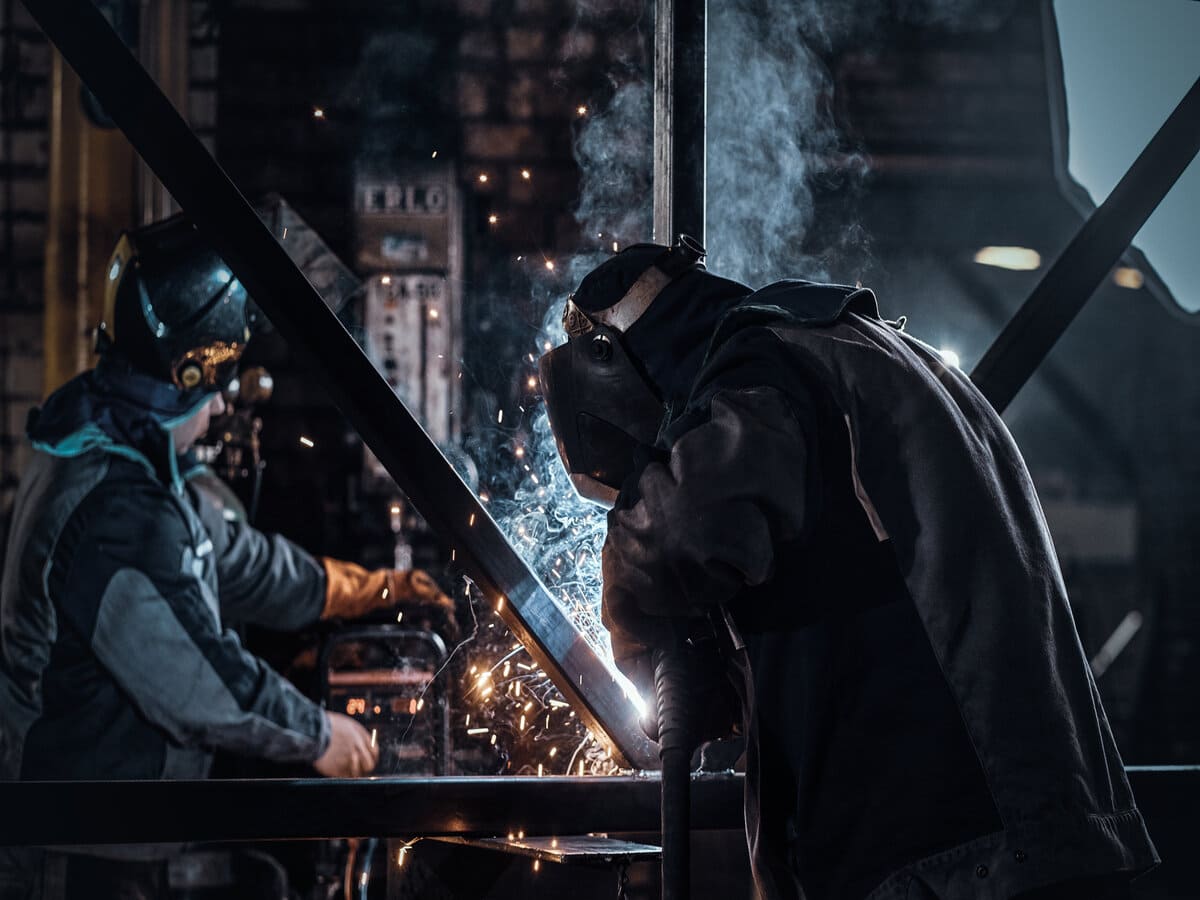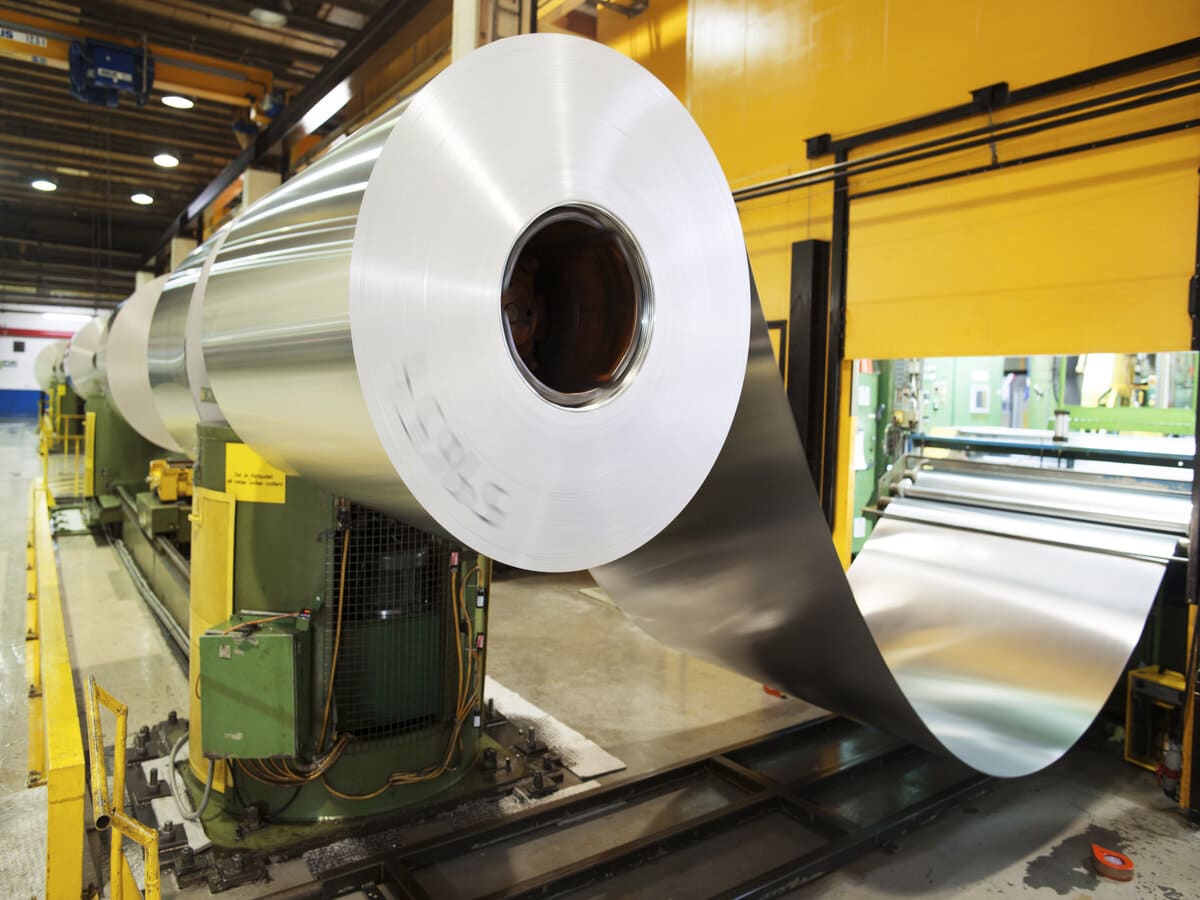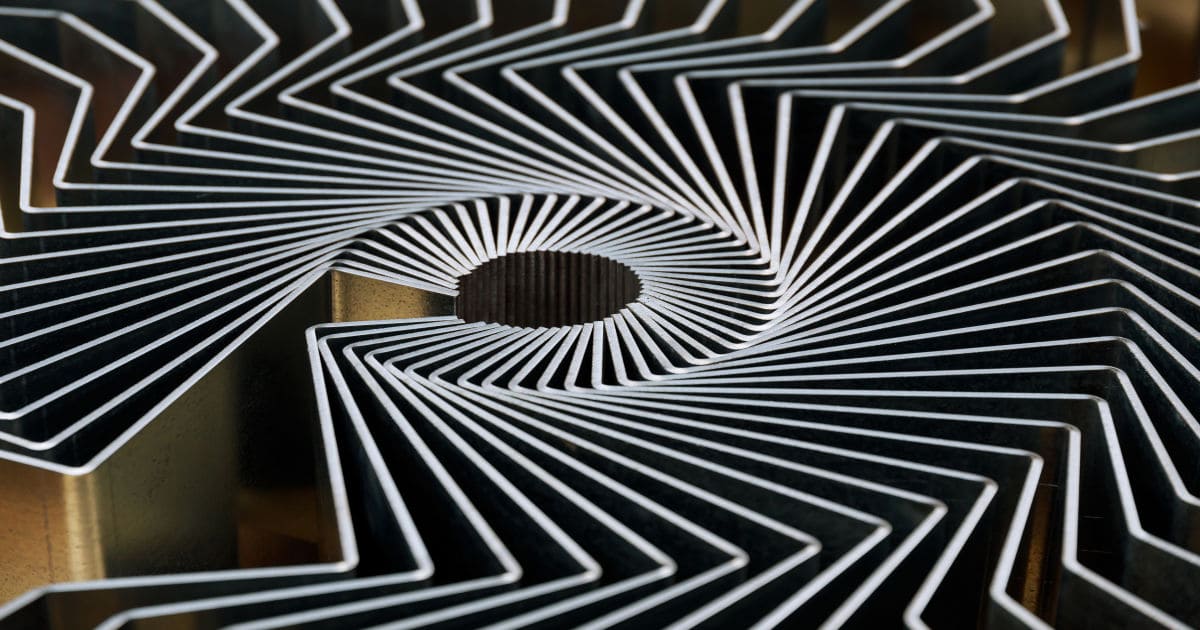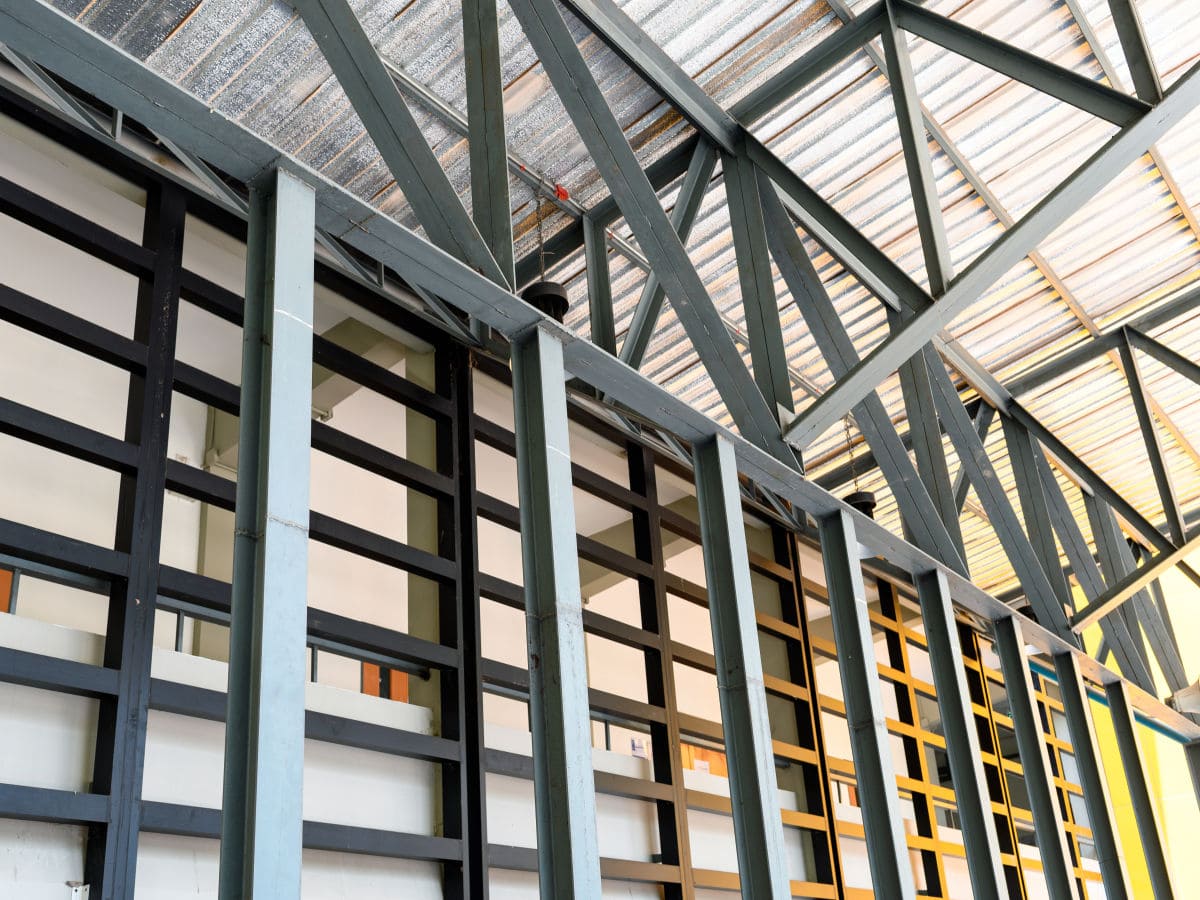In this article, we will look into the world of the 200-ton Press Brake: the mechanics, features, applications, and advantages of this industrial machine are many.
What is a press brake? It is a machine that helps to accurately bend and shape heavy and strong materials like metal sheets.
The high force of the press brake is needed to smoothly fold tough materials into the desired shapes for things we use every day, like cars, appliances, and structural parts for buildings.
Without the press brake, it would be hard to make these strong materials bend properly, and the things we rely on might not work or look how they should.
Understanding the 200-ton Press Brake
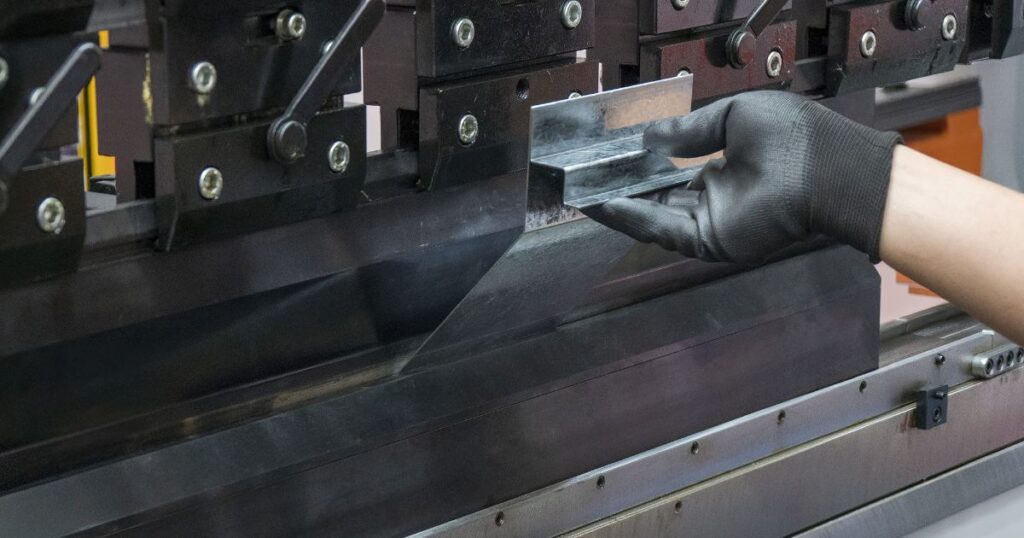
What is a Press Brake?
At its core, a press brake is a vital machine in the metal fabrication industry, designed for sheet metal’s precision bending and shaping. This hydraulic or mechanical press consists of a sturdy frame, a moving ram, and a specialized tooling setup.
The process involves placing a piece of sheet metal between the tooling and using the press to exert force, resulting in a controlled bend according to the desired angle. Moreover, press brakes find applications in various industries, from automotive manufacturing to aerospace.
It is used in manufacturing to bend and shape metal sheets into different forms. It uses a powerful force to press a metal sheet between a top tool (called the punch) and a bottom tool (called the die). This force causes the metal to bend or fold along a specific line, allowing manufacturers to create various shapes like angles, curves, and straight bends.
A press brake is a big tool to bend and shape metal sheets. Imagine it like a giant metal bender. Knowing about it is important because it helps make things we use, like cars and appliances. If you understand a press brake, you can ensure metal parts are bent correctly for safe and strong products.
Press brakes are commonly used in industries requiring precise metal fabrication, such as making car parts, appliances, and construction materials.
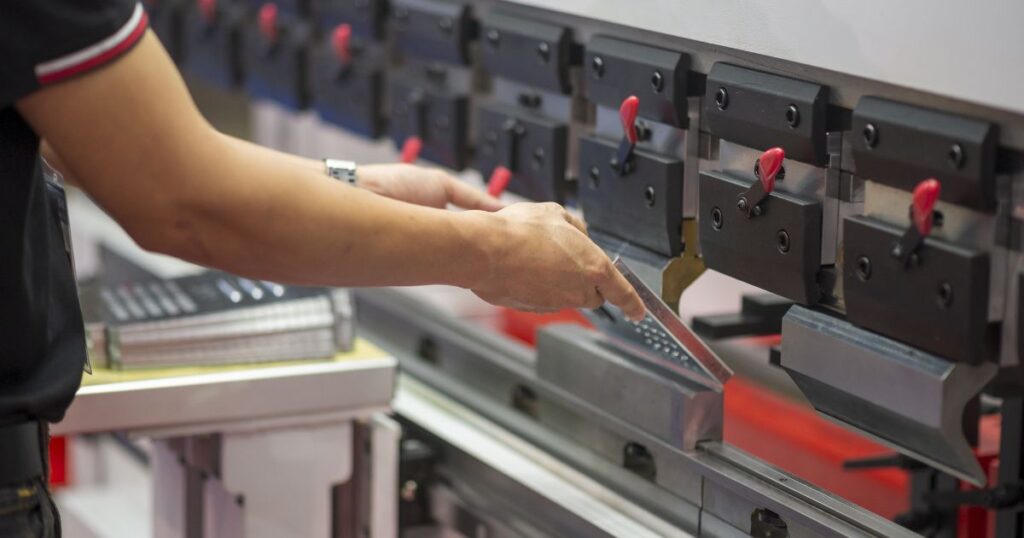
Power and Precision Unleashed
The 200-ton Press Brake takes the metal bending capabilities to a new level. The “200-Ton” indicates the machine’s capacity to apply 200 tons of force during bending. This immense force enables the machine to easily handle thicker and heavier metal sheets. The result? Exquisite bends and shapes that meet the most stringent specifications.
Here’s a list of its capabilities, emphasizing its power and precision:
Bending Thick Sheets
The press brake can easily bend heavy sheets up to 200 tons of force, making it suitable for thick and strong materials.
Accurate Angles
It precisely forms bends at specific angles, ensuring consistent results across various parts.
Complex Shapes
With its power, it crafts intricate shapes in materials without compromising precision.
Multiple Bends
Capable of making multiple bends in a single piece without losing accuracy.
High Capacity
Handles large workpieces while maintaining power and precision, suitable for industrial-level projects.
Repeatable Results
Its precision ensures that each bend is consistently duplicated, minimizing errors.
Heavy-duty Materials
It can shape robust materials like steel and aluminum, displaying strength and control.
Fine Adjustments
Allows for minor adjustments to achieve exact measurements in the final product.
Quick Setups
Despite its power, it can be set up efficiently for different bending jobs, saving time.
Safe Operation
Incorporates safety features to ensure secure usage even with its high force capabilities.
Reduced Waste
Its precision minimizes material waste by producing accurate bends on the first try.
Reliable Performance
Consistently delivers powerful yet precise results over extended periods of operation.
Automated Workflow
It can be integrated into automated systems for efficient and controlled mass production.
Customizable Settings
Offers flexibility in adjusting settings to accommodate various material types and thicknesses.
Operator-Friendly
They are designed with user-friendly controls, making it easier for operators to achieve desired outcomes.
Consistent Bend Radii
Maintains uniform bend radii throughout the bending process, contributing to product quality.
Tight Tolerances
Achieves tight tolerances, ensuring the end product meets exact specifications.
Versatile Applications
Suitable for a wide range of industries, showcasing its adaptability and performance.
Minimal Deformation
Despite its power, it minimizes material deformation, preserving the integrity of the workpiece. Leaves smooth and polished finishes on the bent surfaces due to its precise control.
High-Quality Finishes
A 200-ton press brake excels in bending thick materials with power and precision, offering accurate results for various applications.
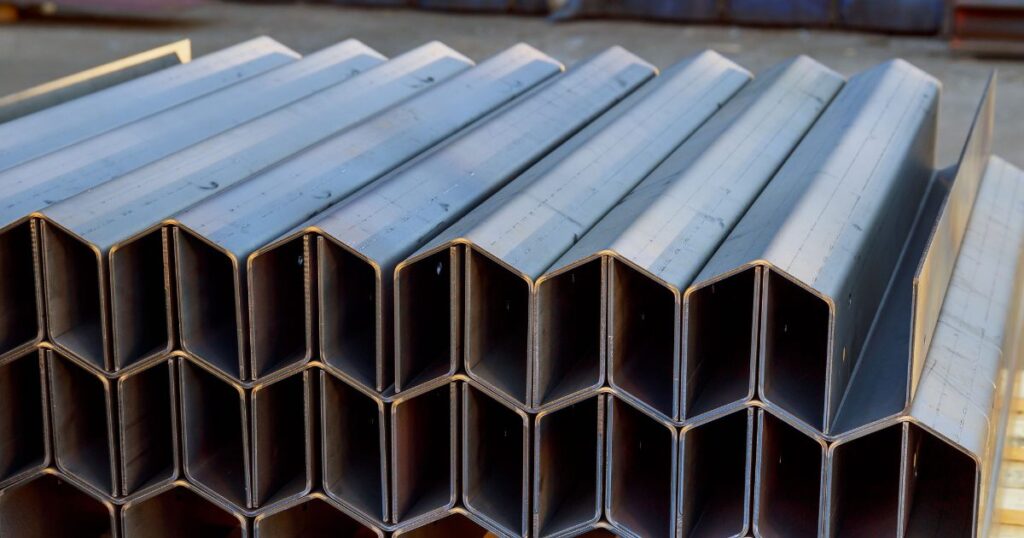
Key Features and Components
Robust Frame and Structure
A solid foundation is the cornerstone of any powerful press brake, and the 200-ton Press Brake is no exception. Its frame is crafted from high-quality, stress-relieved welded steel, providing the necessary stability to handle substantial loads without compromising precision. This robust structure minimizes deflection, ensuring consistent and accurate bending across the entire length of the metal sheet.
Hydraulic System: The Driving Force
At the heart of the Brake is its hydraulic system, responsible for generating the immense force required for bending. The hydraulic cylinders perfectly synchronize, driving the ram and tooling downward. Advanced hydraulic systems incorporate proportional valves and feedback mechanisms, allowing for precise control over the bending process. This level of control ensures that even complex bends are executed flawlessly.
Control Systems: Navigating Precision
Modern press brakes, including the 200-Ton variant, feature sophisticated control systems that offer both convenience and precision. Touchscreen interfaces and intuitive software allow operators to input bending parameters with ease. These systems control the hydraulic pressure, back gauge position, and other critical factors, resulting in consistent and accurate bends. The 200-Ton Press Brake’s control systems are a testament to the marriage of technology and craftsmanship.
Tooling: Shaping Possibilities
The tooling setup is a crucial component of any press brake, and the 200-ton version is no different. V-dies and punch tooling of various sizes and shapes enable various bending possibilities. Punch and die is a cutting tool equipment for punching and forging work. It is a metal-forming process that requires high heat. This process needs a “punch” as a pusher on the cutting workpiece, and the die is a secondary object that the punch pushes in.
The precision and durability of these tooling options ensure that the machine can handle diverse materials and complex geometries. This adaptability makes the 200-ton Press Brake a valuable asset in a rapidly changing manufacturing landscape.
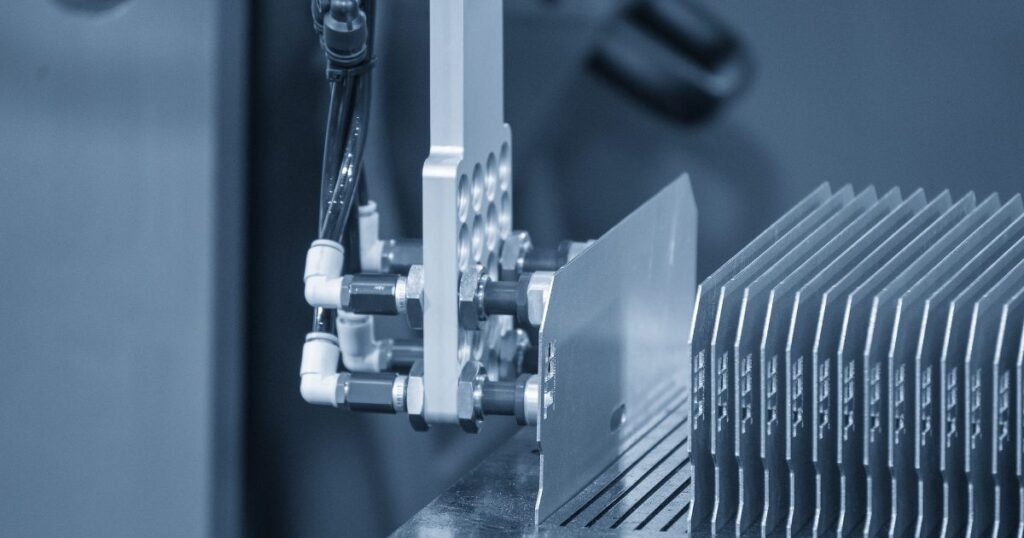
Advantages of 200 Ton Press Brake
Versatile Forming Capabilities
The Brake’s immense force and precision open the door to many forming capabilities. It excels in air bending, bottoming, coining, and more. The material being bent is forced to touch the bottom of the V die. Air bending involves leaving a gap, open air, between the material and the bottom of the die. From creating sharp angles to producing intricate curves, this machine can shape metal sheets according to design specifications, no matter how demanding.
High-Quality Bends for Various Materials
Metal comes in various grades and thicknesses, and the 200-ton Press Brake handles them all with finesse. This machine delivers consistent and high-quality bends, whether stainless steel, aluminum, or mild steel. The controlled force applied during bending minimizes material distortion, resulting in clean, professional-looking bends.
Time and Cost Efficiency
In the realm of metal fabrication, time and cost efficiency are paramount. The 200-ton Press Brake shines in this aspect, offering quick setup times and reducing the need for secondary operations. Its ability to handle larger and thicker sheets means fewer material handling steps, streamlining the production process and reducing overall costs.
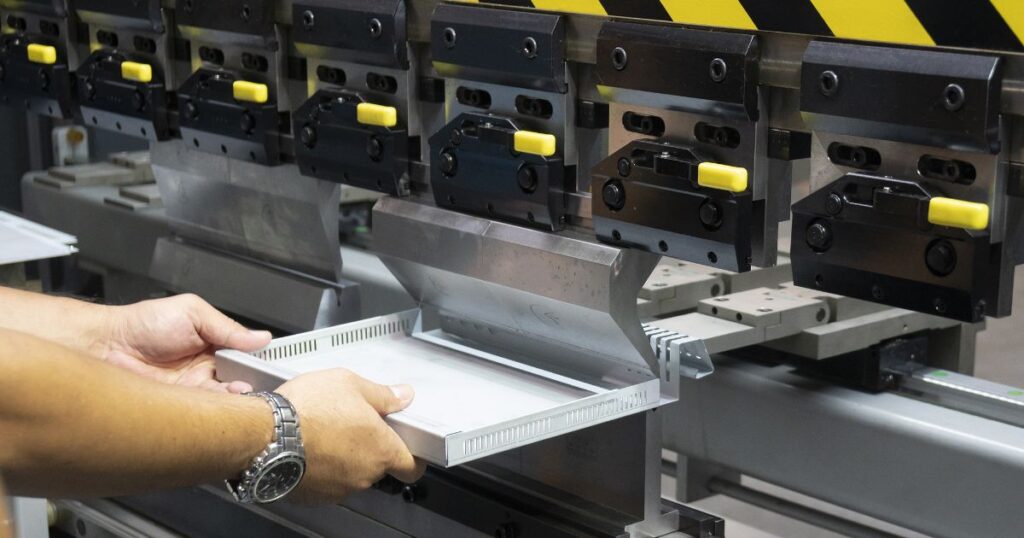
Maintenance and Safety
Regular Maintenance for Optimal Performance
Regular maintenance is essential to ensure it continues operating at its peak. This includes inspecting and lubricating moving parts, checking hydraulic systems for leaks, and verifying the accuracy of the control systems. Scheduled maintenance prevents unexpected downtime and prolongs the machine’s lifespan.
Ensuring Operator Safety: Ergonomics and Controls
Safety is important in industrial settings, and press brakes are no exception. It has safety features such as two-hand operation controls, safety light curtains, and emergency stop buttons. Additionally, ergonomic design considerations, such as comfortable working heights and clear sightlines, contribute to the operator’s overall safety.
FAQs
Q: What is the maximum sheet thickness the 200-ton Press Brake can handle?
A: The 200-ton Press Brake is designed to handle sheet metal with thicknesses depending on the material type.
Q: Can the machine handle complex bend angles?
A: Absolutely! The advanced control systems and versatile tooling of the 200-ton Press Brake make it capable of producing complex bend angles with precision.
Q: Is operator training required to use the press brake?
A: Yes, operator training is crucial. While modern press brakes have user-friendly interfaces, proper training ensures safe and efficient machine operation.
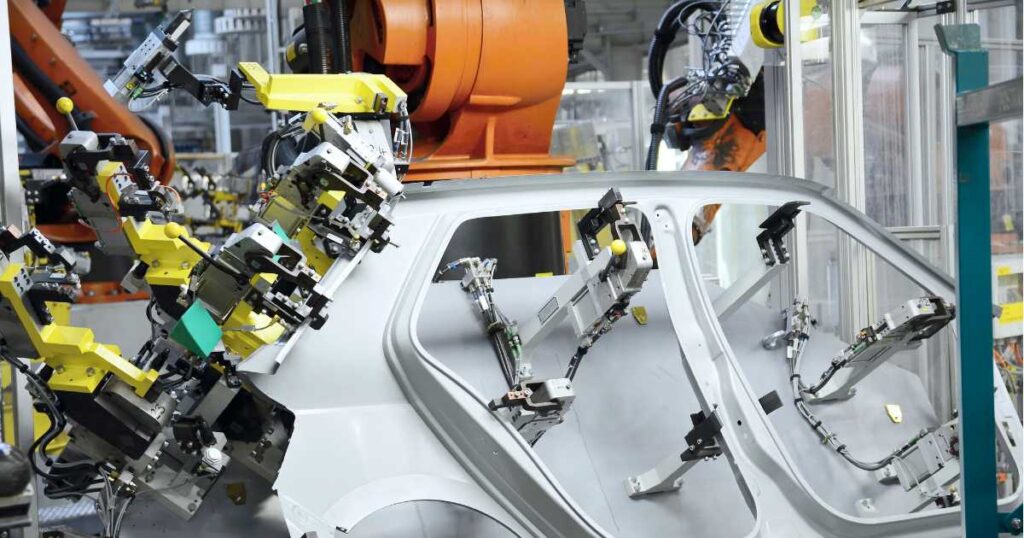
The Press Brake in Action: Real-World Examples
Let’s take a look at how the 200-Ton Press Brake is making an impact in real-world scenarios:
Automotive Industry
The automotive world plays a role in manufacturing various components and parts. Here are some examples of how a 200-ton press brake is used in the automotive industry:
Frame and Chassis Components
Press brakes are bent and shaped sheet metal into various frame and chassis components, such as cross members, brackets, and supports. These parts provide structural integrity and support to the vehicle’s frame.
Body Panels
Press brakes are used to create the complex curves and bends found in car body panels. This includes doors, fenders, hoods, and roof panels. Precise bending ensures that these panels fit together seamlessly, maintaining the vehicle’s aesthetics and aerodynamics.
Body Panels
Press brakes create the complex curves and bends found in car body panels. This includes doors, fenders, hoods, and roof panels. Precise bending ensures these panels fit together seamlessly, maintaining the vehicle’s aesthetics and aerodynamics.
Exhaust Systems
The press brake can form exhaust system components like pipes, connectors, and flanges. Proper bending and forming are essential to ensure these components fit together tightly, preventing exhaust leaks.
Interior Components
Various interior components, such as dashboard brackets, seat frames, and door panels, require accurate bending and shaping. Press brakes create these components with the necessary structural strength and design.
Suspension Parts
Suspension components like brackets and supports must be precisely manufactured to ensure proper alignment and functioning. A 200-ton press brake can shape heavy-duty suspension parts with the required accuracy.
Engine Mounting Brackets
Press brakes create brackets holding the engine and transmission within the vehicle’s chassis. These brackets must be strong and precisely shaped to ensure proper positioning and stability.
Safety Features
Some automotive safety features, such as reinforcing beams in doors and pillars, rely on precise press brake bending to protect passengers during a collision.
Underbody Shields
Many vehicles have underbody shields to protect the undercarriage from debris and impacts. Press brakes create these shields, ensuring they fit snugly and provide effective protection.
Airflow Components
Ducts and channels that direct airflow for cooling purposes, such as for brakes or the engine, require accurate shaping. Press brakes are used to create these components to specific dimensions and shapes.
Brackets and Mounts
Various brackets and mounts for attaching components like radiators, condensers, and cooling fans are manufactured using press brakes. These parts need to be precisely shaped to ensure proper fit and function.
In the automotive industry, precision, durability, and consistency are paramount. A 200-ton press brake’s capabilities make it a vital tool for producing high-quality components that meet these requirements, ultimately contributing to vehicle safety, performance, and aesthetics.

Aerospace Sector
The precision and consistency offered by the press brake are invaluable in aerospace applications, where even the slightest deviation can have significant consequences.
Sheet Metal Fabrication
Aerospace companies use press brakes to shape and bend large sheets of metal into complex forms required for aircraft components. For instance, the fuselage panels of airplanes often need precise bends to fit together perfectly.
Aircraft Wing Components
Press brakes create intricate shapes and angles in aircraft wing components, such as wing skins and spars. These components require accurate bending to maintain aerodynamic efficiency and structural integrity.
Engine Nacelles
The engine nacelles encase the aircraft engines and have curved and aerodynamically optimized shapes. Press brakes bend and form the metal parts that make up the nacelles.
Cabin Interiors
Press brakes manufacture various components of the aircraft’s cabin interiors, including overhead bins, seat frames, and partitions. These parts need precise bending and forming to fit seamlessly within the cabin structure.
Landing Gear Components
Landing gear components require robust and accurately formed metal parts to handle the stresses and strains of takeoffs and landings. Press brakes are used to shape components like landing gear doors and struts.
Spacecraft Structures
In the aerospace industry, press brakes are used not only for aircraft but also for spacecraft. They fabricate structural components of satellites, probes, and other spacecraft, where precision and strength are paramount.
Aerospace Prototyping
During aerospace projects’ development and prototyping stages, press brakes are used to create mock-ups and test components before final production. This helps engineers refine their designs and make necessary adjustments.
Aircraft Modifications and Repairs
Press brakes are also used in maintenance and repair operations. When aircraft components need replacement or repair due to wear, damage, or design changes, press brakes can help fabricate new parts that match the original specifications.
Aircraft Structural Upgrades
As aerospace technology advances, existing aircraft may undergo structural upgrades to enhance performance and safety. Press brakes play a role in fabricating new components that meet the updated specifications.
Prototyping UAVs
The aerospace industry often uses Unmanned Aerial Vehicles (UAVs) or drones that require specialized components, which press brakes can fabricate. Moreover, the prototyping and manufacturing of these components benefit from the precision and flexibility of press brake technology.
In the aerospace industry, where precision, strength, and safety are paramount, a 200-ton press brake is a versatile tool that enables manufacturers to produce complex, high-quality components essential for modern aircraft and spacecraft.
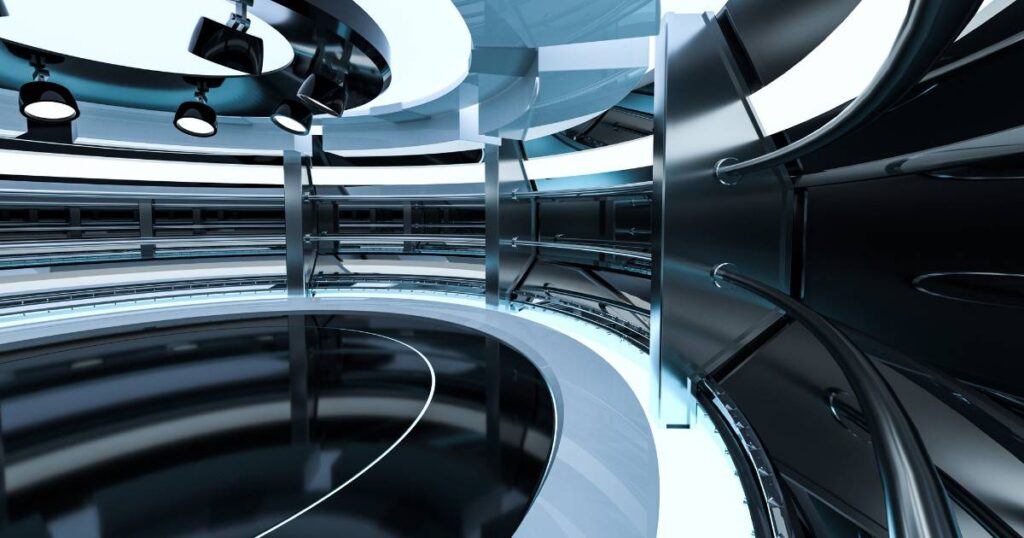
Architectural Creations
Press Brake enables architects and designers to bring their visions to life by bending metal into unique and stunning architectural elements. Moreover, a 200-ton press brake plays a role in transforming raw sheet metal into precisely shaped components that contribute to the overall aesthetic and functional aspects of architectural creations. Furthermore, the machine’s versatility and power make it an essential tool in modern metalworking for architecture.
Metal Facades and Cladding
Press brakes bend and shape metal panels for exterior facades or building cladding. These panels can have intricate designs, patterns, or textures, adding aesthetic value to architectural designs.
Curved Metal Roofs
A 200-ton press brake can create the precise curves required while maintaining structural integrity in architectural designs that call for curved or arched metal roofs.
Structural Elements
Workers use press brakes to fabricate various structural elements. These components provide support and stability to the structure while contributing to its overall design.
Staircases and Railings
Architectural staircases and railings often incorporate custom-designed metal elements. Moreover, a press brake can help create the bends and angles necessary to construct unique and visually appealing staircases and railings.
Decorative Features
Modern architectural designs include decorative metal features, such as ornate grilles, screens, and patterns. A 200-ton press brake creates intricate and precise decorative elements that enhance the structure’s visual appeal.
Art Installations
Artisans use press brakes to shape metal components for large-scale art installations, sculptures, and other artistic architectural elements that enhance the aesthetics of public spaces.
Awnings and Canopies
You can use a press brake to manufacture metal awnings and canopies that provide shade and protection. Furthermore, the machine helps achieve these functional architectural features’ desired curvature and angles.
Custom Windows and Doors
Architectural designs sometimes call for uniquely shaped windows and doors. Moreover, press brake can bend metal frames and casings to fit these custom dimensions.
Sculptural Building Facades
Some contemporary architectural designs incorporate sculptural facades that stand out as artistic and structural features of a building. Furthermore, a press brake can aid in creating the complex geometries required for such designs.
Sustainable Architecture
Press brakes can shape metal components for energy-efficient building designs, such as louvers and shading devices that optimize natural lighting and ventilation.
Resources and References
As you delve deeper into the world of press brakes, here are some resources to expand your knowledge:
– The Fabricator – Metal Fabricating News, Products, Articles, and More(https://www.thefabricator.com/)
– Fabricators & Manufacturers Association, International (FMA)(https://www.fmanet.org/)
– Occupational Safety and Health Administration (OSHA)(https://www.osha.gov/)
And there you have it—your comprehensive guide to the world of the 200-ton Press Brake! From its robust structure to its versatile applications, you now have a solid understanding of this industrial workhorse. Moreover, the 200-ton Press Brake remains a marvel of engineering, transforming metal sheets into works of art with power and finesse.

